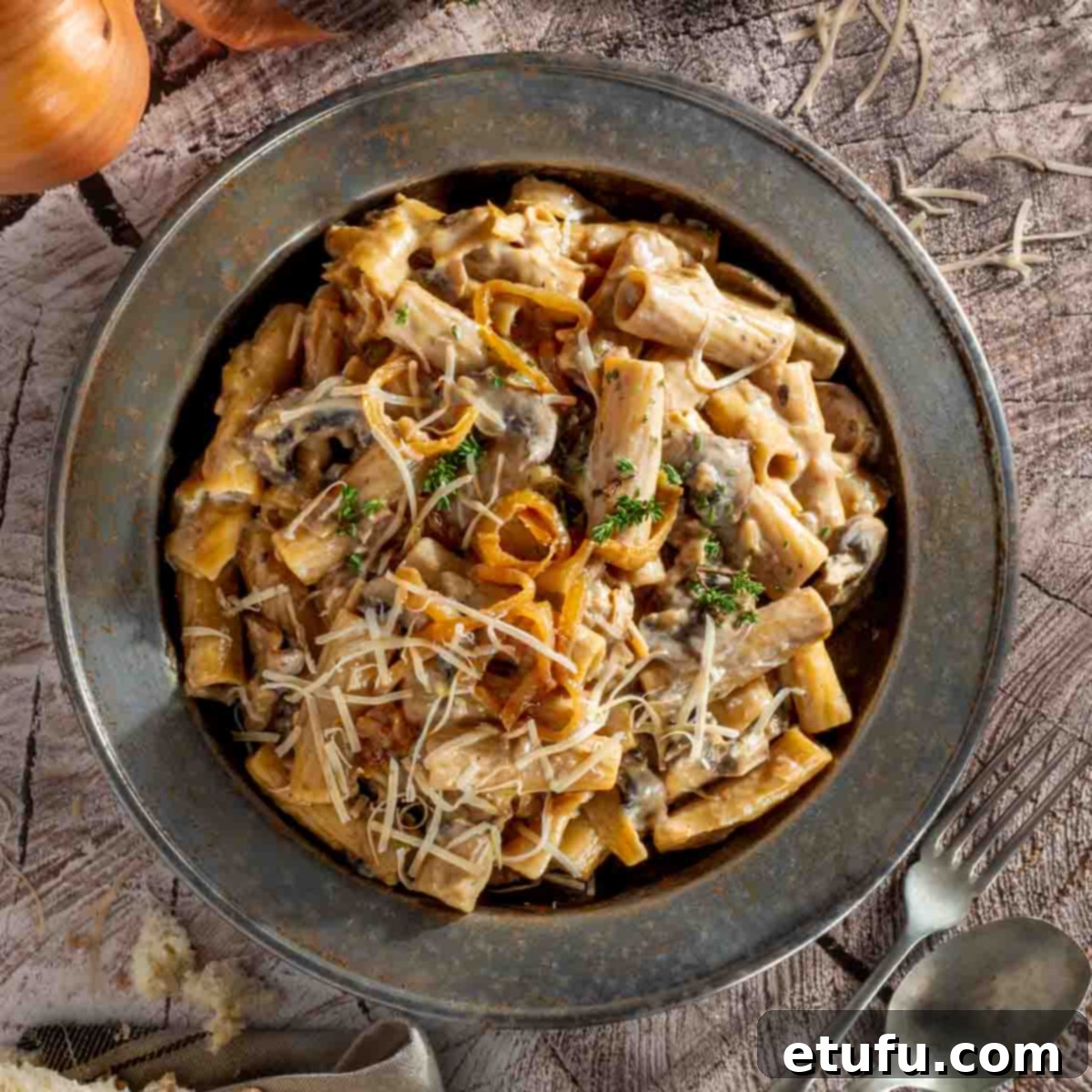Irresistible One-Pot French Onion Pasta: Our Enhanced Take on a Viral Sensation
Prepare to be captivated by a culinary masterpiece: the French Onion Pasta. Originally soaring to viral fame thanks to Carolyn Wong’s ingenious recipe, this dish has become a beloved staple for its profound flavors and surprisingly simple preparation. Here, we present our lovingly refined version, designed to elevate an already exquisite concept into an unforgettable dining experience. Imagine the rich, complex essence of classic French onion soup, masterfully transformed into a creamy, comforting pasta dish – all cooked effortlessly in a single pot. This recipe isn’t just about food; it’s about crafting an elegant, sophisticated meal that delights the senses and warms the soul.
The magic begins with the slow, deliberate caramelization of onions, a process that sweetens and deepens their flavor, creating the foundational richness of the dish. This gentle transformation sets the stage for a truly elegant, one-pot wonder, where every ingredient contributes to a symphony of nuanced tastes. With the addition of nutty, melting Gruyère cheese and a hint of luscious cream, this pasta embodies sophistication in every forkful. It’s truly Très chic, as you’d expect from anything adorned with the word ‘French’!
To ensure your French onion pasta is nothing short of perfection, we encourage you to read through our comprehensive guide. We’ve included essential tips and tricks gleaned from countless culinary experiments, designed to help you avoid common pitfalls and achieve a restaurant-quality result in your own kitchen.
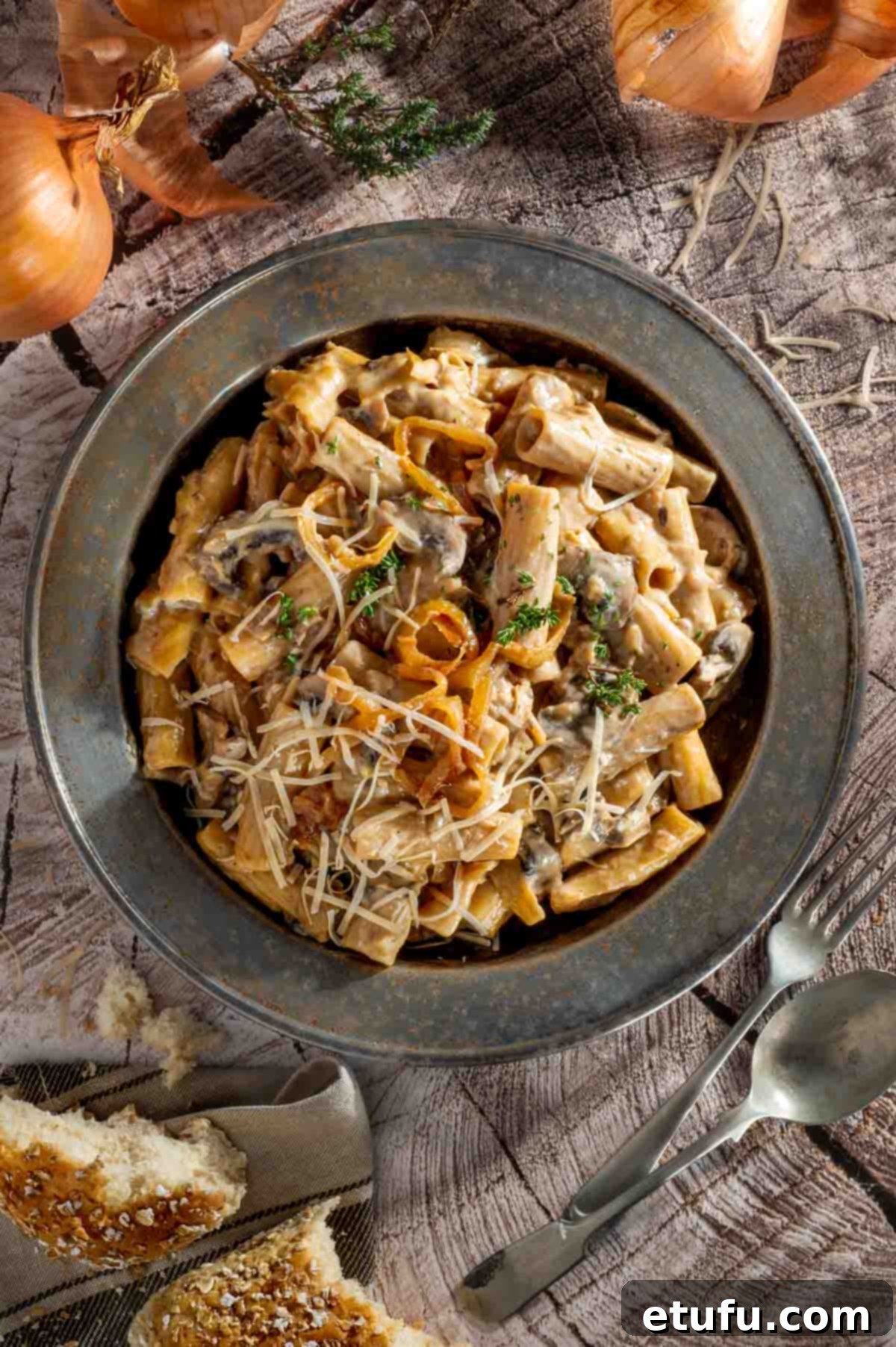
Our Signature Enhancements: Elevating the French Onion Pasta Experience
We want to start by acknowledging the brilliance of Carolyn Wong’s original recipe. It is genuinely fantastic and deserved every bit of the viral attention it received. Our adaptation is not an attempt to surpass her work, but rather an evolution, a thoughtful refinement crafted to align with our specific taste preferences and to enhance certain aspects of the dish we felt could be further developed. Think of it as building upon a great foundation to create something even more uniquely satisfying. Here’s a detailed look at the key changes we’ve implemented:
More Onions: The Heart of French Onion Flavor
One of our primary modifications was to increase the onion count from Carolyn’s one to a generous three large onions. This might seem like a significant jump, but there’s a crucial reason behind it: during the slow caramelization process, onions shrink dramatically. A single onion simply doesn’t provide the robust, deeply savory-sweet French onion soup-inspired flavor that truly defines this dish. By using three onions (approximately 450g/1lb), we ensure a concentrated flavor base that stands up to the pasta and other ingredients, delivering that unmistakable depth and sweetness that is the hallmark of truly exceptional French onion anything. We recommend using white or yellow onions for their balanced sweetness when caramelized, ensuring a rich, foundational taste for your one-pot French onion pasta.
Sherry for a Deeper, Richer Profile
In our version, we’ve replaced all of the dry white wine with an equal amount of sherry. This seemingly minor swap yields a profound difference in the final flavor profile. Sherry, with its complex nutty and slightly sweet notes, contributes a remarkable depth and nuanced sweetness that dry white wine simply cannot match. It perfectly complements the caramelized onions, adding layers of sophisticated flavor that elevate the entire pasta dish, making it taste richer and more complex. If you’re looking for that truly authentic, deeply flavored French touch in your one-pot French onion pasta, sherry is the ingredient that ties everything together beautifully.
Bundling Thyme Sprigs for Convenience
While not a direct ingredient swap, this practical tip significantly enhances the cooking experience. Instead of adding individual thyme sprigs that can be fiddly to remove later, we bundle them tightly with kitchen string. This simple trick allows the herb’s aromatic oils to infuse the dish beautifully during cooking, and then makes for effortless removal before serving. It’s a small detail that saves time and prevents unwanted bits of stem in your finished creamy Gruyère pasta, making for a cleaner, more enjoyable eating experience. This technique can be applied to many other recipes using fresh herbs like rosemary or bay leaves, demonstrating smart kitchen hacks for busy home cooks.
Sherry Vinegar: The Essential Brightener
We opted to replace Worcestershire sauce with sherry vinegar, a change that provides a far more pronounced and refined acidic balance to the pasta. Worcestershire sauce offers umami and a subtle tang, but sherry vinegar brings a bright, fruity acidity that cuts through the richness of the onions, cheese, and cream, preventing the dish from becoming heavy or cloying. If you’ve ever felt a rich recipe lacked a certain “je ne sais quoi” or tasted a bit “flat,” it’s often due to the absence of a vibrant acidic component like vinegar or fresh citrus juice. Sherry vinegar adds that essential sparkle, enhancing all the other flavors and making your homemade French onion pasta truly sing.
Chicken Stock: A Lighter, Brighter Foundation
Our recipe calls for chicken stock instead of the beef stock often found in French onion soup. We find that a high-quality chicken stock provides a cleaner, brighter flavor foundation and results in a more appealing color for the final pasta dish. Beef broth, in our experience, can sometimes be too ‘flat’ yet simultaneously overpowering, unintentionally detracting from the delicate sweetness and complexity of the caramelized onions – which should always be the star of this show. Chicken stock allows the onion and cheese flavors to truly shine in this creamy Gruyère pasta. For those seeking a vegetarian option, simply substitute the chicken stock with an equally good quality vegetable broth, ensuring the dish remains flavorful and satisfying for an easy French onion pasta.
Gruyère Cheese: Authenticity and Unrivaled Melt
To honor the roots of classic French onion soup, we stick to tradition by using Swiss Gruyère cheese, departing from Parmesan. Gruyère is renowned for its nutty, earthy flavor profile and, crucially, its exceptional melting properties. When incorporated into the hot pasta, it melts into a velvety, luxurious sauce, adding a richness and stretchy texture that Parmesan, with its drier, sharper crumble, simply cannot achieve. This change is fundamental to achieving that iconic, comforting, and deeply satisfying French onion soup experience in pasta form, making it the perfect creamy Gruyère pasta.
Heavy Cream for Unmatched Lusciousness
Carolyn’s original recipe wisely suggests that a heavier cream can be substituted for Half and Half, and we wholeheartedly agree and make it a standard in our adaptation. Using heavy cream (or double cream, depending on your region) imparts a final, intensely luscious and velvety quality to the pasta sauce. The higher fat content creates a richer, more indulgent mouthfeel that perfectly rounds out the dish, coating each piece of pasta with a decadent, smooth finish. It’s the secret to that restaurant-quality creamy Gruyère pasta texture that will have everyone asking for seconds.
The Addition of Earthy Mushrooms
A significant, yet incredibly complementary, addition to our recipe is mushrooms. While onions provide sweetness and depth, mushrooms introduce a different dimension of umami, earthiness, and texture that we believe is essential for ‘completing’ the dish. They add a hearty chew and a savory richness that beautifully complements the caramelized onions, creating a more complex and satisfying meal. Mushrooms also contribute a bit of welcome bulk, making the dish feel more substantial and filling. We typically opt for chestnut mushrooms for their robust flavor, but feel free to use your favorite variety to enhance your one-pot French onion pasta.
Why You’ll Fall in Love with This One-Pot French Onion Pasta
This One-Pot French Onion Pasta isn’t just another dinner recipe; it’s an experience waiting to happen. Here’s why we, and countless others, adore this particular dish:
- Effortless One-Pot Perfection: The most appealing aspect for busy home cooks is its true one-pot nature. From the initial caramelization of onions to the final creamy pasta, everything happens in a single saucepan. This means minimal cleanup and maximum flavor integration. The pasta cooks directly in the rich, savory broth, allowing it to fully absorb all the sweet, caramelized onion flavors, creating a depth of taste that boiling pasta separately simply cannot achieve. It’s flavor infusion at its finest, making it a dream for easy French onion pasta nights!
- A Rewarding Culinary Journey: While achieving that perfect, deep caramelization of the onions does require a bit of patience and attentive stirring, the process itself is surprisingly straightforward. This isn’t a complicated dish filled with tricky techniques; it simply asks for a little time and care at the beginning. And trust us, the rich, complex flavors that develop are absolutely worth every minute. The reward is a homemade French onion pasta that tastes far more intricate than its preparation suggests, making you feel like a gourmet chef without the fuss. The slow caramelization of onions is the secret to its unparalleled depth.
- Sophistication on a Plate: Forget your everyday weeknight pasta. This French Onion Pasta is a truly sophisticated and elegant dish, perfect for impressing guests or simply treating yourself to something special. Its nuanced flavors, rich creamy Gruyère pasta texture, and the comforting aroma filling your kitchen will leave a lasting impression. It’s a meal that feels luxurious and indulgent, yet remains accessible for the home cook. Prepare for compliments – this dish is a definite showstopper, a true testament to the elegance of simple ingredients expertly prepared.
Craving more pasta inspiration? Dive into our curated collection of our favorite pasta recipes, featuring a range of delicious and easy-to-make dishes for every palate!
Essential Ingredients: Notes and Smart Substitutions
Understanding your ingredients is key to culinary success, especially when crafting a dish as nuanced as this one-pot French onion pasta. Here’s a deeper look into the core components of our recipe, along with practical substitution ideas to suit your pantry and preferences.
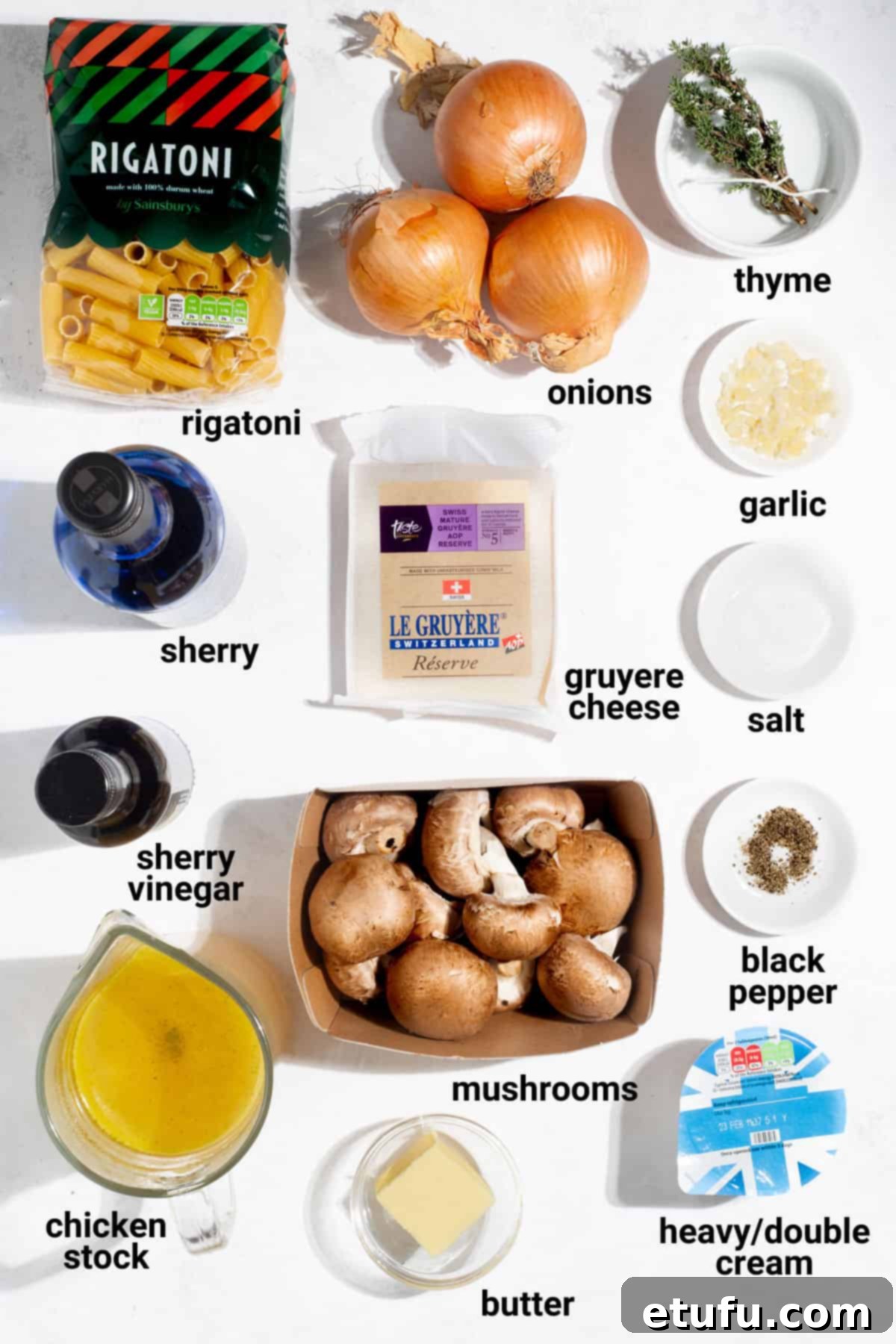
Rigatoni (Dry, Uncooked)
We’ve chosen rigatoni for this recipe simply because it’s a personal favorite, celebrated for its versatility and ability to hold creamy sauces beautifully. Its large, ridged tubes are perfect for capturing the rich French onion sauce, ensuring every bite is packed with flavor. However, the beauty of pasta is its adaptability! Feel free to swap rigatoni for other sturdy, uncooked pasta shapes like penne, fusilli, or orecchiette. These shapes also have excellent sauce-holding capabilities. Ensure you use good quality dry pasta for the best texture and flavor; it makes a noticeable difference in the final dish and helps prevent mushiness in your one-pot preparation.
Onions (White or Yellow)
The foundation of this dish relies on well-caramelized onions, which lend a deep, savory sweetness. To achieve the robust flavor and adequate volume in the final dish, aim for a minimum of 450g (1 lb) of sliced onions, which typically translates to three large white or yellow onions. If your onions are smaller, don’t hesitate to use more. Precision in slicing isn’t paramount, but aiming for rings or half-rings approximately 3-4mm (0.2″) thick ensures even cooking and consistent caramelization. A kitchen mandoline can expedite this process, but a sharp knife and a steady hand work just as effectively. Remember, patience is your best friend when caramelizing onions – don’t rush this crucial step, as it forms the very heart of this French onion pasta.
Sherry
Sherry is a fortified wine that brings a unique nutty sweetness, umami, and depth to the pasta, echoing the complex flavors of traditional French onion soup. If sherry isn’t available, other fortified wines like port, Madeira, dry Vermouth, or Marsala can serve as excellent substitutes, each offering a slightly different but equally compelling flavor profile. For a non-alcoholic alternative, you can increase the amount of chicken or vegetable stock, or use plain water. While this won’t replicate sherry’s complex notes, it will still allow the onions to deglaze and the dish to build its aromatic base flavor effectively.
Sherry Vinegar
This ingredient is vital for adding a bright, acidic counterpoint to the rich and creamy elements of the dish. Its delicate, fruity tang elevates the entire French onion pasta, preventing it from tasting overly heavy. If sherry vinegar is difficult to find, apple cider vinegar or red wine vinegar are suitable replacements. Apple cider vinegar offers a slightly milder, fruitier acidity, while red wine vinegar provides a bolder, more robust tang. Choose based on your preference for acidity, but any of these will help balance the flavors beautifully and bring that essential brightness to your creamy Gruyère pasta.
Mushrooms
Mushrooms add a fantastic umami depth and appealing texture to our French onion pasta. Most varieties will work wonderfully, so feel free to use your favorite! We generally prefer chestnut mushrooms (also known as cremini) for their earthy flavor and firm texture, which holds up well during cooking. White button mushrooms are a readily available and mild option, while more exotic varieties like shiitake or oyster mushrooms can introduce even more profound savory notes. Don’t be afraid to experiment with different types to find your perfect fungal pairing; they are key to adding bulk and complexity beyond just the caramelized onions.
Chicken Stock
The quality of your stock significantly impacts the final taste of your pasta, as it forms the liquid base in which the pasta cooks and absorbs flavor. Wherever possible, opt for a high-quality chicken stock or even homemade broth for the best, most authentic flavor. However, don’t fret if that’s not an option – stock made from good quality stock cubes or concentrated liquid stock works perfectly fine and is a convenient choice for this easy French onion pasta. A crucial consideration: if you’re using unsalted or low-sodium stock, be prepared to adjust the seasoning with additional salt towards the end of the cooking process. Always taste and adjust to your preference to ensure a perfectly seasoned dish.
Crucial Cooking Tips for Perfect One-Pot Pasta Every Time
One-pot pasta recipes are celebrated for their convenience, but they come with specific challenges, particularly concerning liquid absorption and cooking times. Many enthusiastic cooks attempting French onion pasta recipes online have reported two common frustrations:
- A concern that the specified amount of stock is insufficient for properly cooking the pasta, leading to dry or crunchy results.
- The suggested cooking time often falls short, leaving the pasta frustratingly undercooked.
We’ve dedicated considerable effort to fine-tuning the liquid ratios and cooking duration in our recipe to mitigate these issues. However, success also depends on understanding the nuances of one-pot cooking. Here are our essential tips to ensure your one-pot French onion pasta achieves perfect al dente tenderness and a luscious sauce, every single time:
Choose the Right Pot: Foundation for Success
The choice of your cooking vessel is paramount for successful one-pot French onion pasta. We strongly recommend using a heavy-based, lidded saucepan, such as a large Dutch oven or a cast iron casserole dish. These types of pots are ideal because they offer a generous surface area, which is crucial for the proper, even caramelization of the onions. More importantly, their heavy construction ensures superior heat retention and even distribution throughout the cooking time, preventing hot spots and promoting consistent pasta cooking. A thin-based pot can lead to burning, sticking, and uneven heat, all of which compromise the dish’s flavor and texture.

Seal the Deal: Tightly Cover the Pot
Once you’ve added the pasta and liquid, securely covering the pot with its lid is non-negotiable for any one-pot pasta. This step is critical for trapping steam, which is what primarily cooks the pasta in a one-pot method, and preventing excessive liquid loss through evaporation. A tight seal ensures that all the moisture stays within the pot, creating a steamy environment that gently cooks the pasta while allowing it to absorb the flavorful broth. Double-check that your lid forms a snug fit and doesn’t have any small steam holes or gaps that would allow precious moisture to escape and compromise your creamy Gruyère pasta.
Master the Heat: Low and Slow Simmer
After bringing the mixture to a gentle simmer, immediately reduce the heat to the absolute lowest setting on your stove. Maintain this low heat throughout the entire pasta cooking duration. The intense, boiling hot steam trapped inside the tightly covered pot is sufficient to cook the pasta; higher heat will only lead to rapid evaporation of liquid and potentially burnt pasta stuck to the bottom. A low simmer ensures that the pasta cooks evenly and slowly absorbs the broth, becoming infused with the rich caramelized onion flavors without drying out the dish.
Stirring is Caring: Prevent Sticking and Promote Even Cooking
Regular stirring is vital in one-pot pasta recipes, especially for a thick, creamy sauce like this French onion pasta. Make it a point to stir the pasta every 2-3 minutes throughout its 18-20 minute cooking time. This consistent agitation serves a dual purpose: it prevents the pasta from sticking to the bottom of the pot and to each other, and it helps rotate the pasta pieces, ensuring every noodle cooks evenly. Keep your stirs brief and efficient to minimize heat and steam loss from the pot, quickly re-covering the lid each time to maintain the steamy cooking environment.
Trust the Process: Liquid Management
It can be tempting to add more liquid if the pasta doesn’t appear fully submerged, but we urge you to trust the process. If you’ve followed our guidelines regarding liquid amounts and pot usage, you should rarely need to add extra stock or water during the 18-20 minutes of pasta cooking. Remember, the steam trapped under the lid plays a significant role in cooking the pasta, even those pieces that aren’t completely submerged. Only intervene with a small splash of liquid (about ¼ cup) if the pot seems genuinely dry and the pasta is still very firm after 15 minutes of cooking, and you’re making this easy French onion pasta.
Embrace Adaptability: Use Your Judgment
Every kitchen setup is unique. Stove temperatures can vary, pot bases differ in thickness, and not all lids seal perfectly. If you find your pot has a thinner base, a lid that doesn’t seal tightly, or your stove runs hotter even on its lowest setting, you’ll need to use your culinary intuition. Don’t be afraid to adapt! This might mean adding a bit more liquid proactively, shifting the pot to a smaller burner, or even placing a heavy object on top of a loose-fitting lid to improve its seal. Learning to adjust to your specific cooking environment is a hallmark of a confident home cook and will ensure your homemade French onion pasta is a success.
Step-by-Step Guide: Crafting Your Perfect French Onion Pasta
Follow these detailed steps to create a truly spectacular one-pot French onion pasta that will impress and delight with its rich, complex flavors and creamy texture.
Preparation is Key

- Begin by preparing your fresh ingredients: slice the mushrooms, grate the Gruyère cheese, and measure out your chicken broth. Having everything ready beforehand makes the cooking process smooth and enjoyable, especially for a one-pot meal.
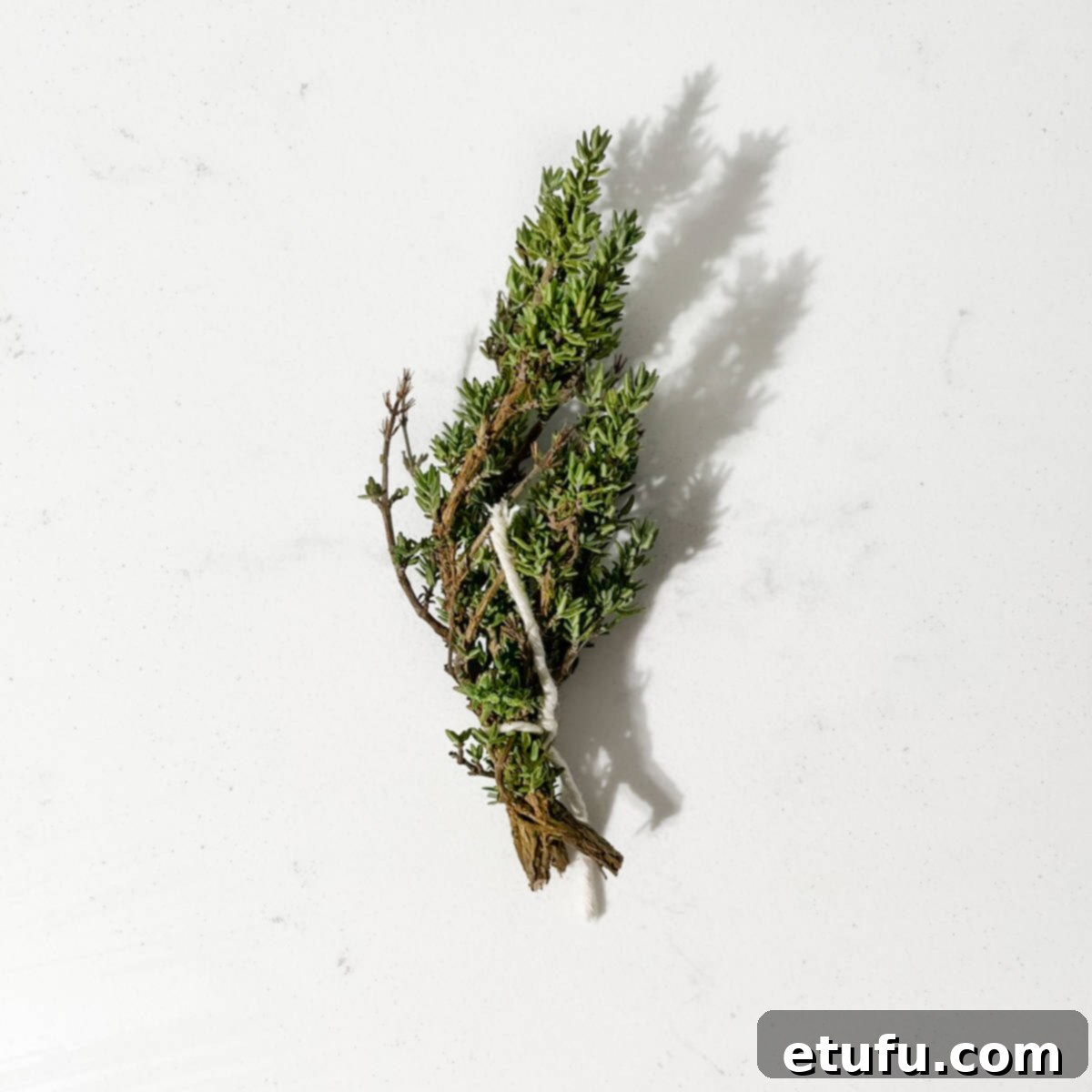
- Gather the fresh thyme sprigs and tie them together securely with a piece of kitchen string. This clever trick allows the thyme to infuse its aromatic flavor into the dish while making it incredibly easy to remove later, ensuring no stray stems remain in your creamy Gruyère pasta. Set the bundle aside.
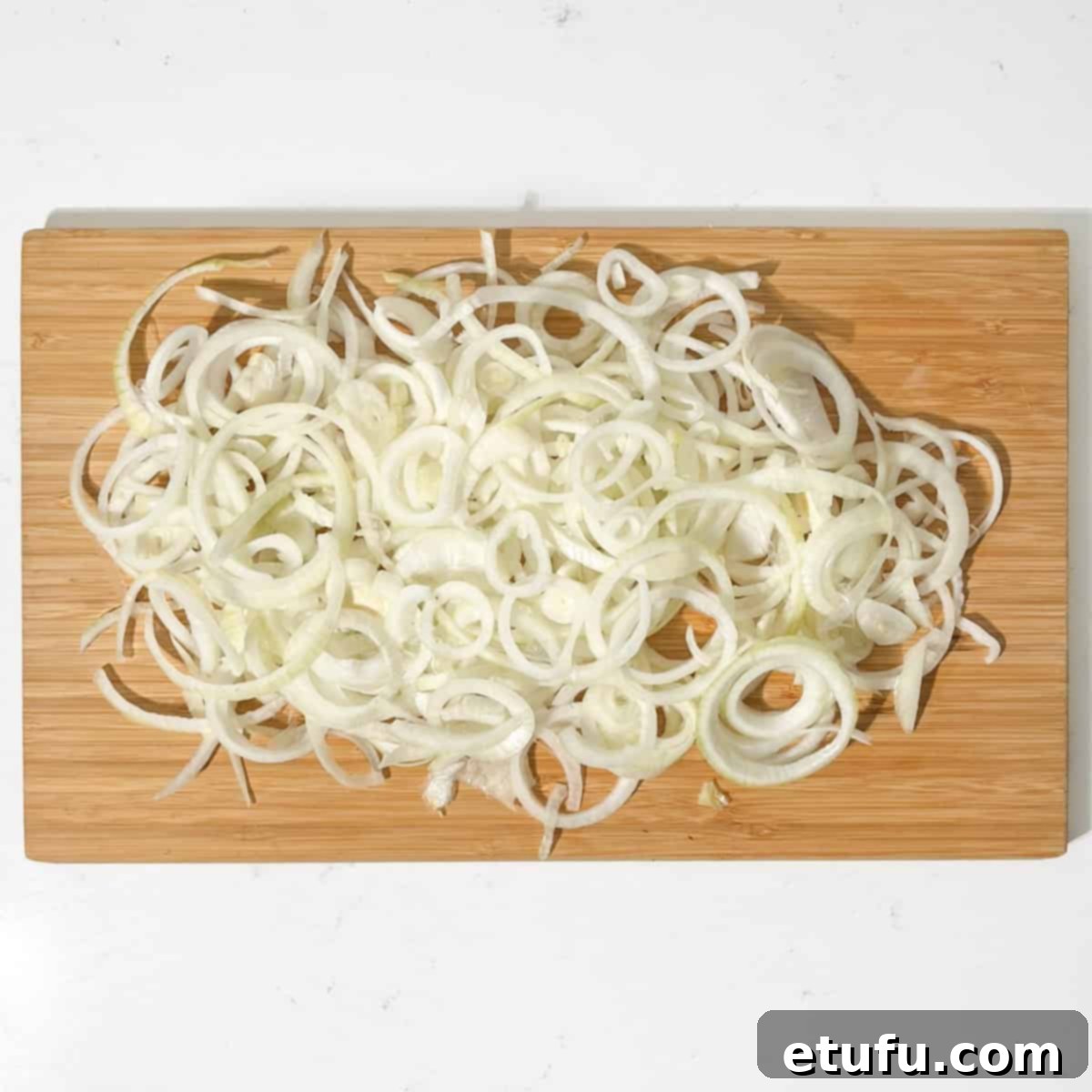
- Carefully slice your onions into uniform rings or half-rings. Aim for a thickness of approximately 3-4mm (0.2 inches). You can use a kitchen mandoline for consistent slices, or a sharp knife will work just as well. Don’t worry about perfection; slight variations are absolutely fine, as these onions will be slowly caramelized to form the base of your homemade French onion pasta.
Crafting the Delicious Pasta

- In your chosen large, heavy-based pot (like a Dutch oven), melt the butter (or olive oil if preferred) over medium heat. Add the meticulously sliced onions along with the salt. Cover the pot with its lid and allow the onions to cook undisturbed for 5 minutes. After this initial period, remove the lid and give the onions a thorough stir, ensuring they are evenly coated and beginning to soften for their eventual caramelization.

- Continue to cook the onions, now uncovered, over a consistently low heat for an additional 25 minutes. This slow process is key to achieving a deep, golden-brown caramelization, which develops their exquisite sweetness and rich flavor, crucial for the French onion pasta. Stir the onions every 2-3 minutes, making sure to scrape any delicious brown bits from the bottom of the pot. If the onions begin to stick excessively, add a very small splash of water (about a tablespoon) as needed. Try to hold off on adding water until the last 10 minutes of cooking, allowing the sugars to concentrate.
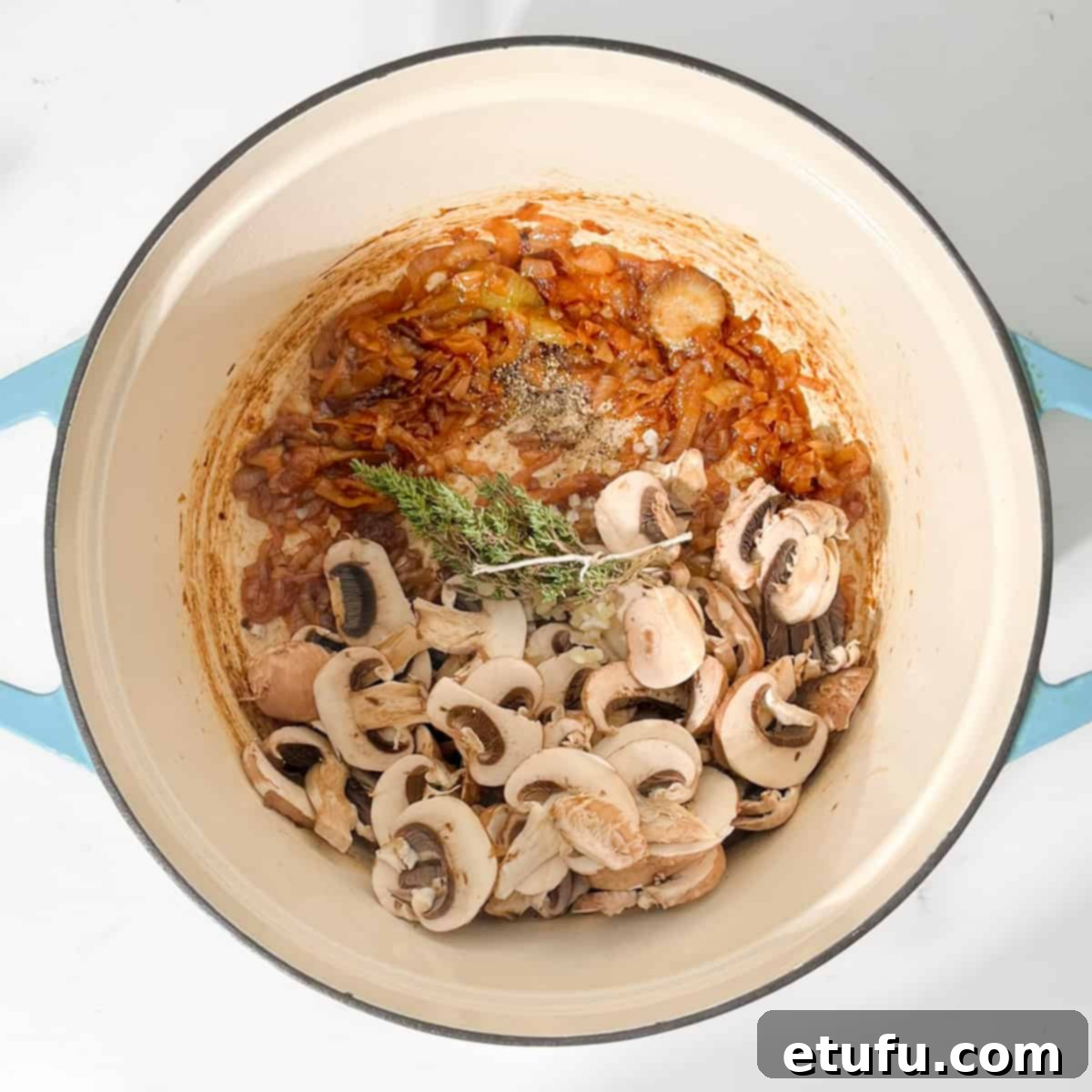
- Once the onions are beautifully caramelized, add the sliced mushrooms, finely chopped garlic, the bundled thyme, and black pepper to the pot. Sauté this mixture over low heat for 3-4 minutes, stirring gently, until the mushrooms soften and begin to shrink slightly, releasing their earthy aromas and complementing the caramelized onions.
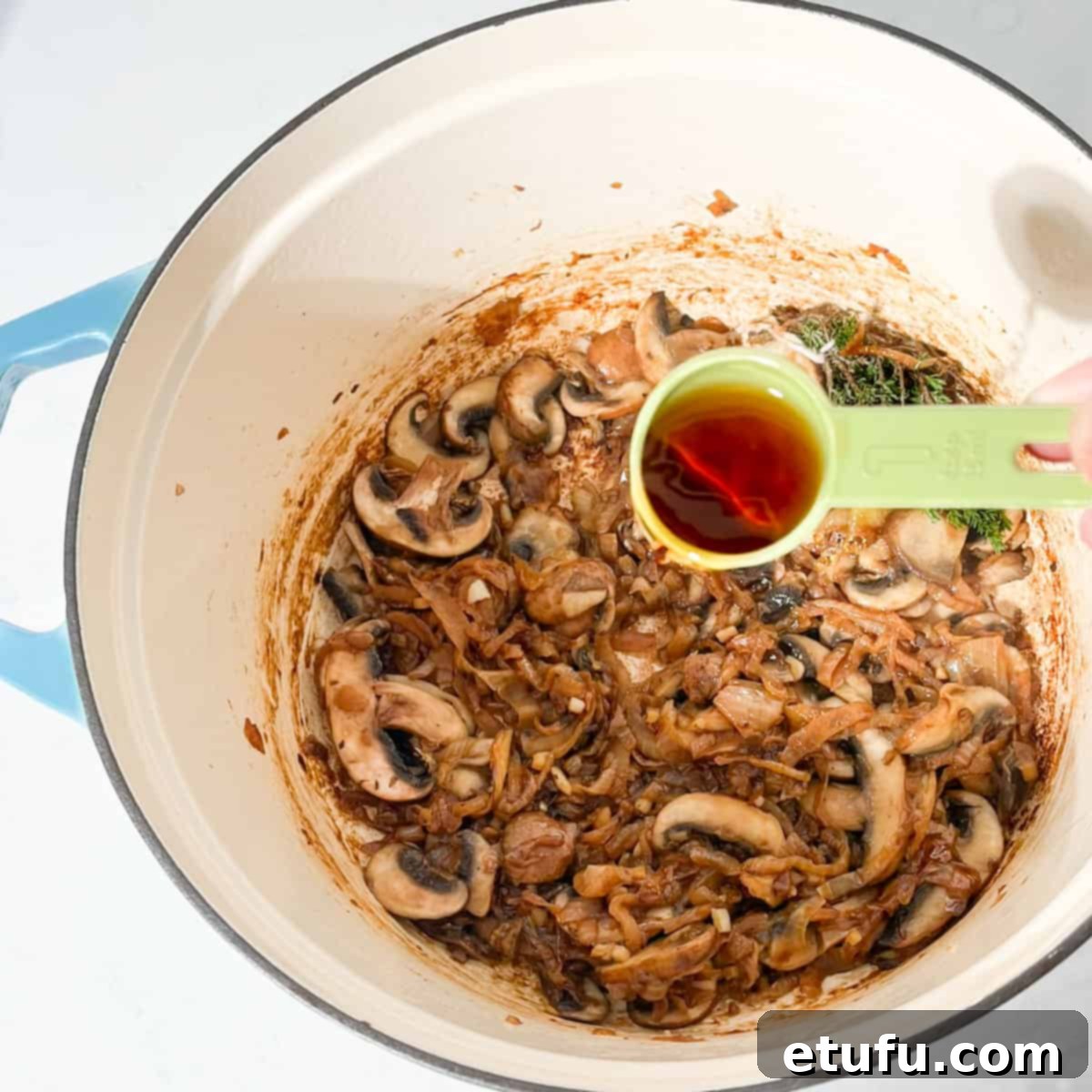
- Pour in the sherry. This step is crucial for deglazing the pan and adding depth, bringing a complex nutty sweetness to the French onion pasta base.
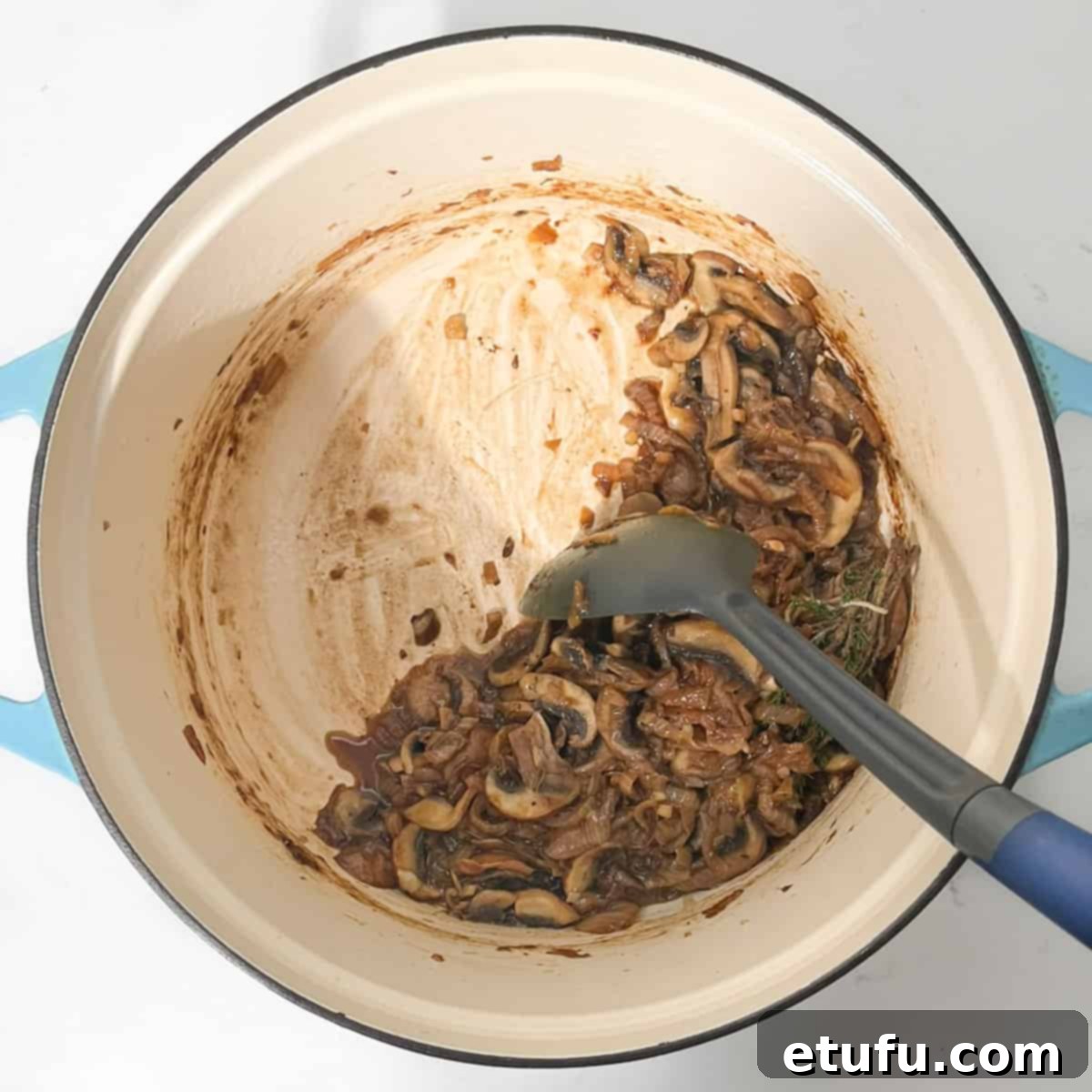
- Actively deglaze the pan by using a wooden spoon or spatula to scrape off any flavorful brown bits that have stuck to the bottom. These concentrated bits are packed with umami and will contribute significantly to the overall taste of your creamy Gruyère pasta sauce.

- Now, pour in the chicken stock, add the dry rigatoni pasta, and the sherry vinegar. Stir the mixture well to combine all ingredients and bring it to a gentle simmer. Once simmering, securely place the lid on the pot and reduce the heat to its lowest setting. Cook for 18-20 minutes, or until the pasta is al dente. Remember to stir the pasta every 2-3 minutes during this phase, keeping the lid off for as brief a time as possible to retain steam and ensure even cooking for your one-pot French onion pasta.
- As a general rule, with the lid on, you typically won’t need to add more liquid. However, always trust your instincts. If the pot appears excessively dry and the pasta is still very firm after 15 minutes, add a small splash (about ¼ cup) of extra stock or water.

- Once the pasta is cooked to your liking, remove the pan from the heat. Carefully take out and discard the bundle of thyme sprigs.
- Stir in the grated Gruyère cheese and heavy cream. Fold gently until the cheese has melted completely and the sauce is smooth and creamy. If the cheese isn’t melting as desired, you can return the pan to a very low heat for about a minute, continuing to fold the cheese into the pasta until it’s perfectly incorporated, creating a truly luxurious creamy Gruyère pasta.
- Taste the pasta and adjust the seasoning as needed. You might want to add a little more salt or pepper to perfect the flavor profile and ensure every spoonful is perfectly balanced.
- Plate up and serve immediately, garnished with a sprinkle of fresh chopped thyme leaves and, if desired, a little extra grated Gruyère or a few additional caramelized onion slivers on top for an even more luxurious presentation. Enjoy your magnificent One-Pot French Onion Pasta!
Elevate Your Meal: Inspired Serving Suggestions
While this One-Pot French Onion Pasta is undeniably satisfying on its own, pairing it with complementary sides can transform your meal into a truly complete and delightful culinary experience. Here are some ideas to enhance your serving:
- Crusty Bread Companions: Serve alongside warm, crusty garlic bread, our easy-to-make 2-ingredient flatbreads, or delicious crispy rolls. These are perfect for soaking up every last drop of the rich, creamy French onion sauce, ensuring no flavor is left behind.
- Fresh Salads for Balance: Cut through the richness of the pasta with a refreshing side salad. A vibrant Panzanella Toscana salad offers bright, juicy flavors, or try a delicate nectarine salad with rocket and basil dressing for a unique sweet and peppery contrast, balancing the creamy Gruyère pasta beautifully.
- Protein Boost: For a heartier meal, consider adding cooked protein directly into the pasta or serving it on the side. Cubes of pan-fried chicken breast, crumbled seasoned ground beef, or even sliced sausage can integrate beautifully with the existing flavors, turning your easy French onion pasta into a more substantial main course.
- A Touch of Balsamic Glaze: A delicate drizzle of high-quality balsamic glaze just before serving can add a visually appealing finish and a subtle tangy sweetness that perfectly complements the dish’s savory and creamy notes, enhancing its gourmet appeal.
- Extra Caramelized Onion Garnish: If you have any leftover caramelized onions (or specifically cook a small extra batch), using them as a garnish can intensify the French onion flavor and add an attractive, gourmet touch to each plate of your homemade French onion pasta.
Storage, Reheating, and Freezing Best Practices
Planning ahead or managing leftovers is easy with this French Onion Pasta. Here’s how to properly store, reheat, and even freeze your delicious creation to enjoy later:
Storage: Allow any leftover French onion pasta to cool completely to room temperature before transferring it to an airtight container. Store it promptly in the refrigerator, where it will remain fresh and delicious for up to 2-3 days. Proper cooling and sealing are crucial for food safety and flavor preservation.
Reheating: To reheat, gently warm the pasta in a saucepan over low to medium heat on the stovetop. Stir it occasionally to ensure even heating and to prevent sticking. The sauce may thicken slightly upon cooling, so don’t hesitate to add a splash of extra chicken stock, milk, or cream to restore its original creamy consistency and lusciousness as it reheats. Avoid high heat to prevent the sauce from breaking or the pasta from becoming mushy.
Freezing: While freezing pasta can sometimes alter its texture, this dish freezes surprisingly well. For best results, portion the cooled pasta into freezer-safe airtight containers or heavy-duty freezer bags, leaving a little space at the top for expansion. Label with the date to keep track. Thaw the pasta overnight in the refrigerator before reheating as described above. Be aware that the pasta may be slightly softer after freezing and thawing, but the rich, creamy Gruyère flavors will remain wonderfully intact, making it a convenient make-ahead meal.
Discover More Irresistible Pasta Recipes
If you’ve enjoyed the comfort and profound flavors of our One-Pot French Onion Pasta, we’re sure you’ll love exploring other delightful pasta dishes from our extensive collection. Expand your culinary repertoire with these fantastic and diverse recipes, perfect for any occasion:
Steak Pasta with a Creamy Whisky and Mushroom Sauce
Gigi Hadid Pasta: The Famous Instagram Spicy Vodka Pasta
Creamy Chicken and Chorizo Pasta
The Best Marry Me Chicken Pasta: A Tuscan-Inspired Delight
Quick & Easy Tuna Pesto Pasta
Refreshing Curry Noodle Salad
Recipe: One-Pot French Onion Pasta

One Pot French Onion Pasta
Equipment
- 1 large, heavy-based, lidded saucepan – like a Dutch oven/cast iron casserole pot
Ingredients
- 225 grams (½ lb) mushrooms – like cremini, chestnut etc
- 85 grams (3 oz) Gruyere cheese, grated
- 700 millilitre (3 US cups) chicken stock
- 4 sprigs thyme
- 3 large (minimum 450g/1 lb) onions, sliced – white or yellow
- 2 tablespoons butter, heaped – or olive oil
- ½ teaspoon salt
- 2 teaspoons garlic, chopped
- ¼ teaspoon black pepper
- 4 tablespoons sherry – or madeira, port, marsala, dry vermouth or more stock
- 225 grams (½ lb) dry rigatoni pasta – or penne
- 1 tablespoon sherry vinegar
- 6 tablespoons double cream (heavy cream) – or to taste
Instructions
Prepping
- Slice the mushrooms, grate the cheese and prepare the stock.225 grams (½ lb) mushrooms, 85 grams (3 oz) Gruyere cheese, grated, 700 millilitre (3 US cups) chicken stock
- Take the sprigs of thyme and tie them together using a piece of string. Set aside.4 sprigs thyme
- Slice the onions into rings or half rings using a kitchen mandoline or a sharp knife. Aim for a thickness of approximately 3-4mm (0.2″). No need to be perfect.3 large (minimum 450g/1 lb) onions, sliced
Making the pasta
- Melt the butter over medium heat. Add the sliced onions and salt. Cover with a lid and let it cook for 5 minutes. After this time, take off the lid and give the onions a good stir.2 tablespoons butter, heaped, ½ teaspoon salt
- Continue cooking the onions, uncovered, over low heat for an additional 25 minutes until they turn a deep, golden brown colour. Stir the onions every 2-3 minutes, making sure to scrape the bottom of the pot as you do so.
If the onions begin to stick, add a small splash of water as necessary. However, try to avoid adding water until the last 10 minutes of cooking.
- Next, add the sliced mushrooms, chopped garlic, bunch of thyme and black pepper to the pot. Sauté the mixture over low heat for 3-4 minutes until the mushrooms begin to shrink slightly.2 teaspoons garlic, chopped, ¼ teaspoon black pepper
- Add the sherry. Deglaze the pan by scraping off any bits stuck to the bottom. This adds extra flavour to the dish.4 tablespoons sherry
- Pour in the chicken stock, add the dry pasta and sherry vinegar. Stir the mixture and bring it to a gentle simmer. Securely place the lid on the pot and cook over low heat for 18-20 minutes until the pasta is al dente. Stir every 2-3 minutes. Keep it brief to avoid losing too much steam.225 grams (½ lb) dry rigatoni pasta, 1 tablespoon sherry vinegar
- Typically, there’s no need to add more liquid when cooking with the lid on. However, trust your instincts and if absolutely necessary, add a small splash of extra stock or water.
- Take the pan off the heat and remove the bunch of thyme.
- Stir in the grated cheese and cream. If the cheese isn’t melting as desired, briefly return the pan to low heat for a minute while gently folding the cheese through the pasta.6 tablespoons double cream (heavy cream)
- Test for seasoning and add more if needed.
- Plate up and serve with additional cheese on top and a sprinkle of chopped thyme.
Notes
Please read:
Numerous French onion pasta recipes can be found online, yet a prevalent issue echoed in user feedback for these recipes revolves around two key points:
- Many express concern that the specified amount of stock in the recipe they chose is insufficient for properly cooking the pasta.
- Another recurring feedback is that the suggested time frame often falls short, leaving the pasta undercooked.
We’ve put a lot of effort into getting the stock and cooking time just right, but here are some simple tips to make it even better:
Use the right pot
Opt for a large, heavy-based, lidded saucepan such as a Dutch oven or a cast iron casserole dish. This type of pot is ideal as it offers a generous surface area for the proper caramelisation of onions and ensures even heat distribution throughout the cooking time.
Cover the pot tightly once the pasta is added
Once you’ve added the pasta, tightly cover the pot. This helps trap the steam, preventing excessive liquid loss during the pasta cooking process.
Make sure the lid forms a tight seal and doesn’t have any openings, such as a small steam hole, to retain the steam effectively.
Cook over low heat
When it starts simmering, turn the heat down to the lowest setting. Keep it low throughout the cooking time. The blazing hot steam trapped inside the pot is enough to cook the pasta.
Stir frequently
Remember to stir the pasta every 2-3 minutes or so throughout the 20-minute cooking time. This helps ensure it doesn’t stick to the bottom and rotating the pieces ensures even cooking. Keep it brief to avoid losing too much steam.
Only add liquid if needed
Trust the process and only add extra liquid if absolutely necessary. If you follow the guidelines and use the recommended amount of stock, you shouldn’t need to add more during the 20 minutes of cooking.
Even if some pieces of pasta aren’t fully submerged, the steam trapped under the lid will help cook them, along with frequent stirring.
Use your noggin
If you’re using a pot with a thinner base, a poorly sealing lid or a stove that’s too hot even on low heat, think on your feet and use your judgement.
Consider adding a bit more liquid, shifting to a smaller burner or placing something heavy on the lid to secure it better. Adapt as needed for your cooking setup.
**Nutritional Data Disclaimer**
Please keep in mind that the nutritional information provided below is calculated by a third party and we cannot guarantee the accuracy. We try our best to give you the most accurate information, but we do not take responsibility for errors that may be present. Also, the nutritional value of the recipe may change depending on the exact brands and products used. We recommend that you consult with a qualified healthcare professional or registered dietitian for personalised advice on your dietary needs.
Nutrition
For food safety advice, including guidance on food allergies
